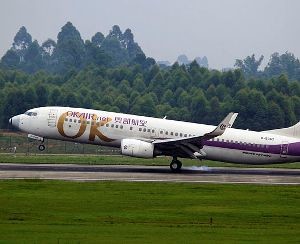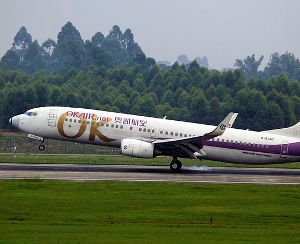 The growing e-commerce industry in China and nearby countries has prompted five companies led by Chinese carrier Okay Airlines to put up a new air express cargo airline that will be launched next year.
The growing e-commerce industry in China and nearby countries has prompted five companies led by Chinese carrier Okay Airlines to put up a new air express cargo airline that will be launched next year.
Okay Airlines, U.S.-based lessor and transport provider Air Transport Services Group (ATSG), China-based online discount retailer Vipshop Holdings, and two other firms recently signed a joint venture agreement to establish United Star Express Airlines Co. Ltd.
To be launched in mid-2016 pending government approval, United Star Express Airlines will be serving multiple destinations within China (including Hong Kong, Macau, and Taiwan) and surrounding countries.
The venture will be registered in Tianjin’s free trade zone (Dongjiang Free Trade Port Zone) and has an initial capitalization of CNY400 million (US$63 million). Okay Airlines will provide the largest share of the registered capital, with its chairman Wang Shusheng as the JV company’s chairman and Richard Corrado, chief commercial officer of ATSG, as the vice chairman.
The new airline will principally serve rapidly growing express air cargo demand driven by e-commerce growth in China and surrounding countries. From 2010 through 2014, the express market has been growing at an average rate of 30% per year.
Express air services in China now rely mostly on excess capacity in the belly of passenger aircraft. Fewer than 120 all-cargo freighters operate within China, and only a small portion of those serve express markets, said ATSG in a statement.
“The growth rate of China’s e-commerce markets exceeds that of the air express market. Therefore, United Star Express will provide third-party express and charter aircraft services that cover the country and surrounding Asia regions to domestic and international express companies.”
Gradually, the company plans to add medium- and long-distance cross-border express and cargo charter services that cover Europe and the America regions.
United Star Express will have its own airline operating certificate and operate independently to international standards, with its own independent airline insignia, fleet, routes, and organization.
Within the first year of its flight operations, the company will deploy six small and midsize freighter aircraft, including Boeing 737, Boeing 757 and Boeing 767 aircraft.
Air cargo market still weak
Meanwhile, the weakness in air cargo markets extended to the month of August for Asia-Pacific based carriers, although demand still recorded positive figures over the past eight months, according to traffic figures released recently by the Association of Asia Pacific Airlines (AAPA).
The subdued air cargo demand in August led to a slight 0.3% decline in volume in freight tonne kilometer terms compared to the same month last year, said AAPA. Offered freight capacity grew by 3.3%, and consequently the average international freight load factor fell by 2.2 percentage points to 61% for the month.
“Air cargo markets remain weak, reflecting a further slowdown in world trade in recent months,” said Andrew Herdman, AAPA director general. “Overall, however, after accounting for the initial growth spurt earlier this year, air cargo demand has still registered a 3.0% increase for the first eight months of the year.”
Herdman concluded, “The outlook for air cargo markets is more uncertain, given signs of weakness in global trade activities, but should see some seasonal demand as we move towards the end of the year.”
HKIA throughput declines
As this developed, Hong Kong International Airport (HKIA) likewise saw cargo volume drop in August, skidding by 1.2% to 361,000 tonnes compared to the same month last year.
The decline was mainly attributed to the 5% year-on-year drop in transshipments. Exports registered a slight growth, while imports decreased by 1% compared to the same month last year. Among the key trading regions, China and Taiwan registered the most significant drop in the month. Traffic to and from Europe grew most significantly compared to other key regions.
In the first eight months of this year, HKIA handled 2.8 million tonnes of cargo, representing growth of 0.1%, over the same period last year. On a rolling 12-month basis, cargo throughput grew by 1.6% to 4.4 million tonnes.





